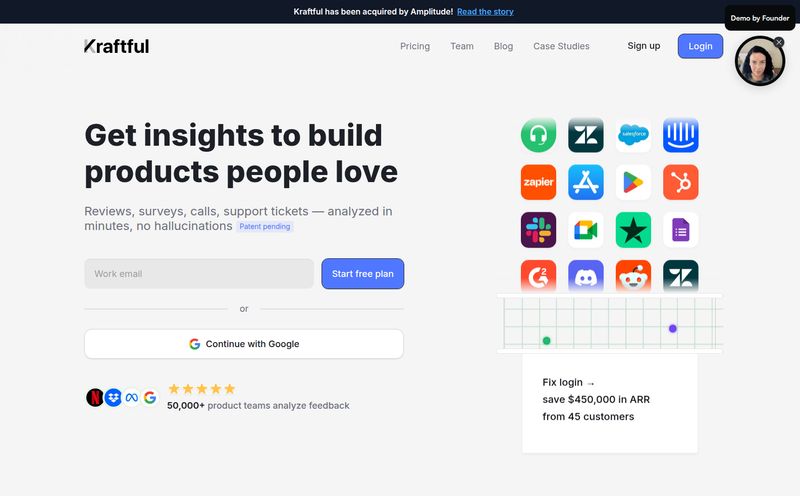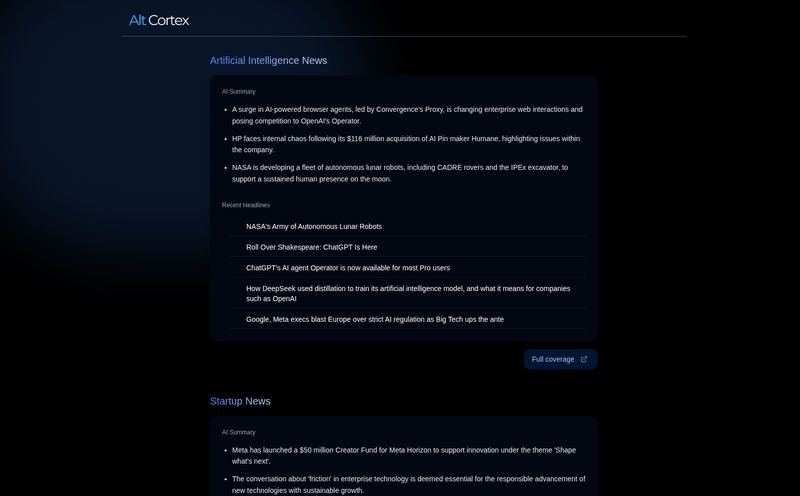You ever stumble upon a piece of tech that just clicks? You see it, you get it, and you think, “Yes! Someone is finally solving this mess.” That was me when I first caught wind of Neurelo. In the wild west of AI development, where we’re all trying to chain together LLMs, agents, and our precious, precious data, Neurelo felt like the sheriff who’d finally bring some order to town.
It promised a secure, intelligent bridge between our increasingly clever AI agents and the databases they need to be truly useful. It was a fantastic idea. And then, just like that, it was gone. If you head over to their site now, you’re greeted with a simple, somber message: “Our Journey Has Come to a Close.”
It’s a story we see all the time in tech, but it doesn't make it any less of a bummer. So, instead of a typical tool review, let's do something a little different. Let's pour one out for a fallen startup and do a little post-mortem. What was Neurelo trying to do, why was it so important, and what can we learn from its story?

Visit Neurelo
The AI-Database Problem is a Real Headache
Before we talk about Neurelo's solution, let's talk about the problem. It’s a big one. Giving an AI agent, like something you've built with LangChain or a custom framework, direct access to your production database is... well, it’s terrifying. It’s like handing a brilliant but incredibly naive and literal-minded intern the keys to your entire company archives. What could possibly go wrong?
You’ve got a few major worries:
- Security: How do you stop the AI from seeing sensitive data it shouldn't? Think PII, financial records, etc.
- Integrity: How do you prevent a poorly phrased prompt from being interpreted as
DELETE FROM users;? It sounds hyperbolic, but we're in uncharted territory here. - Performance: An AI agent might decide the most efficient way to answer a question is to query a massive table ten thousand times. There goes your database performance, and your cloud bill.
- Complexity: Juggling connections, writing custom query logic, and handling different database dialects (Postgres, MySQL, Mongo) for your AI is a massive development overhead.
For years, we’ve been building clunky middleware and writing endless boilerplate code to act as a go-between. It’s slow, brittle, and frankly, no fun to build. This is the dragon Neurelo set out to slay.
So What Exactly Was Neurelo?
At its heart, Neurelo was a super-smart, AI-aware database interface. It sat between your application/AI and your database (it supported PostgreSQL, MySQL, and MongoDB, which covers a huge chunk of the market) and generated a secure API layer on top of it. Instant REST and GraphQL APIs, right out of the box. That alone is a pretty sweet deal for any developer.
But the secret sauce was how it was tailored for AI workflows. It wasn't just about creating endpoints; it was about creating a safe, observable, and efficient environment for AI agents to interact with data.
The Features That Made Me Nod in Approval
I get pitched on new dev tools every single day, and most of them are just slight variations on something that already exists. A few of Neurelo's ideas, however, felt genuinely fresh and, more importantly, necessary.
Deterministic Access and Security Guardrails
This was the big one. Neurelo allowed you to set up fine-grained access controls. You could define exactly what data an AI agent was allowed to see or modify, based on roles or other rules. It created a secure sandbox. The goal was deterministic access—meaning you could be confident the AI would behave predictably, without those terrifying “creative” moments that lead to data loss. They also included event logging and runtime controls, giving you an audit trail to see exactly what your digital intern was up to.
GitSchema: Version Control for Your Database
Oh, this was clever. Neurelo introduced a concept called GitSchema. Essentially, it was like bringing the workflow of Git to your database schema management. You could define your data models in a declarative way, version control them, and collaborate with your team just like you do with code. Anyone who has ever had to manage database migrations on a large team knows what a pain it can be. This was a really elegant approach.
Observability for AI Data Interactions
Another huge win. When an AI is hitting your database, you're often flying blind. You don’t know why it’s running a specific query or how efficient it’s being. Neurelo provided a layer of observability specifically for these interactions. You could see what your agents were doing, spot inefficiencies, and understand their behavior. In a world where AI can be a black box, this was a much-needed window.
The End of the Journey
So with all these great ideas, what happened? Their closure notice says it best: “Startups are a journey of experiments, pivots, and growth.” This is the unglamorous truth of Silicon Valley and the tech world at large.
Looking at the clues from their old materials, we can make some educated guesses. The product was listed as “In Beta,” and a previous iteration, “Neurelo Build,” was already deprecated. This points to a company in flux, likely trying to find the perfect product-market fit in a ridiculously fast-moving industry. The AI space is not for the faint of heart. What's revolutionary in January is standard feature in a major platform by June.
My personal take? They were on the right track, but maybe a little too early, or perhaps the challenge was just too big for a startup to tackle alone. Major cloud providers and database companies like MongoDB and Neon are all racing to build their own integrated AI tooling. Competing with that kind of momentum is a monumental task.
It's a shame, really. I believe the problem of a universal, secure AI-database layer still exists. We need a Switzerland for our data—a neutral, trusted party that can speak to any database and any AI framework. Neurelo was one of the first real contenders for that title.
What We Can Learn from the Ghost of Neurelo
The demise of a good idea doesn’t make the idea any less good. The core problems Neurelo identified are more relevant than ever.
- The Need for AI Guardrails is Critical. Don't just connect your AI to a database with full privileges. The need for an abstraction layer with robust security, logging, and access controls is not optional; it's essential.
- Developer Experience Matters. The appeal of Neurelo wasn't just security, but simplicity. Auto-generated APIs, GitSchema... these things save developers time and cognitive load. Whatever solution you build or buy, it has to be easy to work with.
- The Market is Still Wide Open. While Neurelo didn't make it, their ghost haunts a massive opportunity. Someone will crack this nut, whether it's an open-source project, another startup, or a feature from a major player. Keep your eyes peeled.
Frequently Asked Questions
What was Neurelo?
Neurelo was a platform designed to simplify and secure database access for AI agents. It automatically generated REST and GraphQL APIs on top of existing databases like PostgreSQL, MySQL, and MongoDB, with built-in security, observability, and AI-friendly workflows.
Why did Neurelo shut down?
The company announced it was winding down operations in 2024. While no specific public reason was given beyond the natural challenges of a startup, it was likely due to a combination of factors common in the fast-paced AI market, including intense competition and the difficulty of finding a sustainable product-market fit.
What was Neurelo's pricing?
Neurelo never had a public, fixed pricing page. Its main offering, Neurelo Connect, was in a private beta, which typically means pricing was handled on a case-by-case basis through direct contact with their sales team. There was no established monthly subscription fee for the public.
Are there any good alternatives to Neurelo?
There isn't a perfect 1:1 replacement, but you can piece together a solution. Tools like Hasura or PostGraphile can auto-generate GraphQL APIs from your database, which is a good start. For the Object-Relational Mapping (ORM) and schema management side, Prisma is a fantastic tool. However, the specific AI-centric security and observability features of Neurelo are harder to replicate out-of-the-box and might require custom development.
What was the core problem Neurelo was trying to solve?
The core problem was the immense difficulty and risk associated with connecting AI agents directly to live databases. Neurelo aimed to solve the security, data integrity, performance, and complexity challenges by providing a secure and intelligent middleware layer.
A Final Thought
It’s easy to look at a closed website and a 404 error and just move on. But it’s worth taking a moment to appreciate the attempt. Building something new, especially in a field as chaotic and hyped as AI, is incredibly hard. The team at Neurelo took a shot at a very real, very difficult problem. They may not have crossed the finish line, but they certainly helped map out the race course for whoever comes next. And for that, they have my respect.
Reference and Sources
- Neurelo's official closure announcement (link now defunct).
- Prisma - An example of a modern ORM and database toolkit.
- Hasura - A platform for instant GraphQL on your data.



